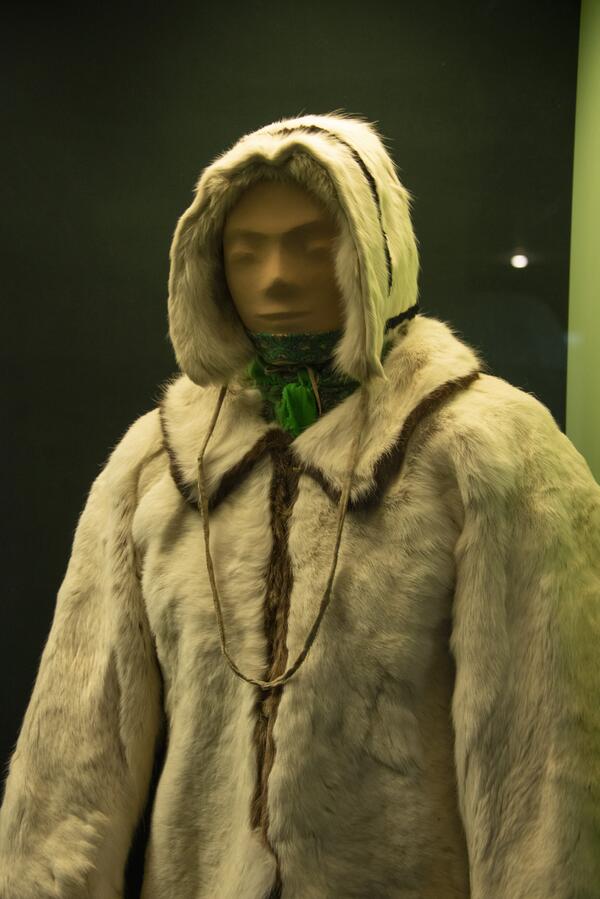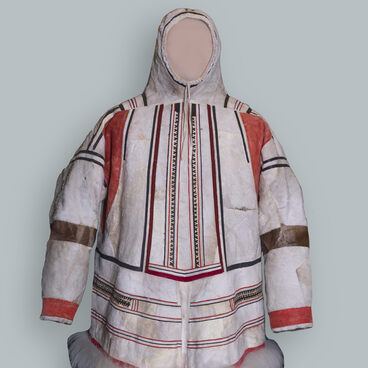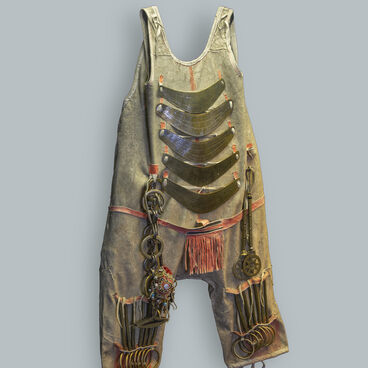There are about 20 types of traditional Dolgan clothes, which look vibrant and have a lot of decorative elements. Since ancient times it has been customary to use all the colors of the rainbow in clothing: in the past, subdued, pastel hues were favored, now — brighter ones.
Among the widespread ornaments are “arda” patterns, made in zigzag lines resembling the outlines of mountains divided by clefts (“ardayan” means “open”), and beaded “fingernails” (when making them the craftswomen outlined their fingernails). There are also patterns (or “ukhory”, according to the Dolgan pronunciation) borrowed from Russian and Ukrainian clothes.
Unlike many other peoples of the North, Dolgans have long made outer clothing in one layer. Under it, to keep warm they put on coats from Arctic fox or hare skins, and on top — a sewn-on collar from fox fur. Sewing patterns were not used.
To make a piece of clothing, hides with equally short pile were first carefully selected and dressed. This ancient technique required long and hard monotonous work, but the result was far superior to chemical treatments. The hide became strong and supple, and the pile retained its natural shine. Traditionally, dressing hides was considered a woman’s occupation.
The deer hide was first dried by stretching it on poles. The next step was scraping, using five different scraping tools. The skin was smoked for two days to make it waterproof, and then scraped again.
This was followed by the next step — the tanning. Reindeer liver was used as the main ingredient. It was boiled, chewed, and mixed with the decoction; the chewing served not only for mincing: the saliva promoted further fermentation. The skin was smeared with this thick mixture on the skin side, rolled up, and left to soak overnight. After a few hours, the skin got soft.
On the next day, the liver mass was scraped off, the parings were removed, and the skin was kneaded with a special scraper to make it even softer.
Only the raw material prepared in this way was ready for cutting.
This short, straight-cut parka is made from white and dark-colored reindeer hides with the fur facing outwards. It is tied up line-on-line with buckskin leather straps. The hem is lined with white polar fox fur.
Among the widespread ornaments are “arda” patterns, made in zigzag lines resembling the outlines of mountains divided by clefts (“ardayan” means “open”), and beaded “fingernails” (when making them the craftswomen outlined their fingernails). There are also patterns (or “ukhory”, according to the Dolgan pronunciation) borrowed from Russian and Ukrainian clothes.
Unlike many other peoples of the North, Dolgans have long made outer clothing in one layer. Under it, to keep warm they put on coats from Arctic fox or hare skins, and on top — a sewn-on collar from fox fur. Sewing patterns were not used.
To make a piece of clothing, hides with equally short pile were first carefully selected and dressed. This ancient technique required long and hard monotonous work, but the result was far superior to chemical treatments. The hide became strong and supple, and the pile retained its natural shine. Traditionally, dressing hides was considered a woman’s occupation.
The deer hide was first dried by stretching it on poles. The next step was scraping, using five different scraping tools. The skin was smoked for two days to make it waterproof, and then scraped again.
This was followed by the next step — the tanning. Reindeer liver was used as the main ingredient. It was boiled, chewed, and mixed with the decoction; the chewing served not only for mincing: the saliva promoted further fermentation. The skin was smeared with this thick mixture on the skin side, rolled up, and left to soak overnight. After a few hours, the skin got soft.
On the next day, the liver mass was scraped off, the parings were removed, and the skin was kneaded with a special scraper to make it even softer.
Only the raw material prepared in this way was ready for cutting.
This short, straight-cut parka is made from white and dark-colored reindeer hides with the fur facing outwards. It is tied up line-on-line with buckskin leather straps. The hem is lined with white polar fox fur.



